- V
- GF
- NS
- DF
- View Recipe Key
How to Make David Chang’s Momofuku Ramen at Home
How to Make David Chang’s Momofuku Ramen at Home
Want to recreate the Momofuku ramen experience at home? Following this step-by-step, detailed recipe will elevate your ramen game to celebrity chef levels.
This post contains affiliate links. Full disclosure is at the bottom of the article.
Over 10 years ago, I discovered ramen. Not the “instant” type of ramen but rather the complex, gourmet soup made with several components prepared with love and care. Since there were no restaurants serving it in my hometown (the first ramen joint would open over 5 years later), I’d watch it made on TV and online, and I’d read about it in blogs and cookbooks. The more I learned about the craft of making ramen, the more I craved it.
Soon enough, tasting and eating ramen became an obsession during my travels. When I visited cities such as New York, Paris, and eventually (finally!) Tokyo, I’d research the best ramen places to visit before any other types of restaurant. From bowl to bowl, I sampled a wide variety of broths, different thicknesses and textures of noodles, and all sorts of different toppings, from the most conventional to the most creative. In other words, I discovered the sheer amount of work that goes into those bowls of comfort.
Back home, I’d whip up shortcut ramen, bathing dry ramen noodles in store-bought chicken stock, topping them with whatever protein I had on hand—rotisserie chicken, ground pork, fried tofu—and adding a ton of fresh veggies for color and flavor. These bowls weren’t authentic in the least, but they were comforting and satisfying. And, in any case, I didn’t ever consider that it would be possible to make ramen that would even come close to what specialized restaurants served.
Enter the Momofuku cookbook. Back in 2009, David Chang was a celebrity chef, but he wasn’t yet the icon he would eventually become. I bought his first cookbook wanting to learn more about this witty, unconventional chef who seemed to follow no rules and no one. I’d heard a lot about his New York City ramen joint, Momofuku, and, since I’d yet to visit it in person, I figured I’d learn more about what made it unique through the namesake cookbook.
David Chang’s Momofuku cookbook is an entertaining read: you could very well go from cover to cover without cooking anything from it and still fully appreciate the book. Chang tells page-turning stories about his childhood and past experiences, and, though it feels and looks a lot like a coffee-table book, once you get into the recipes, you realize Momofuku is also a surprisingly approachable cookbook. Chang’s casual tone guides you through each recipe and every step as if he were in the kitchen with you. Though many of the recipes are time-consuming, they read like you could actually achieve them, and get satisfying results to boot—not always a given with celebrity chef cookbooks.
After juggling with the idea for a while and reading the recipe dozens of times, I decided I’d try my hand at making the Momofuku ramen. I’d yet to make it to the New York City restaurant, but maybe I’d get to enjoy its iconic soup at home and learn a thing or two about ramen along the way.
Since then, I’ve made the Momofuku ramen broth several times, slightly adapting and tweaking it to make it easier to pull off in my home kitchen. I use only ingredients I can find easily and take shortcuts to make the recipe achievable in a few hours. Yes, making Momofuku ramen is a project, but the recipe does make a big batch of broth, which means you’ll get to enjoy the fruits of your labor in many delightful ramen bowls to come.
“Ramen = broth + noodles + meat + toppings and garnishes. It’s that simple and that complex, because variations are endless.” —David Chang, Momofuku cookbook.
What I love most about Chang’s approach to cooking in general and ramen in particular, is that he’s not elitist about it. He hasn’t ever claimed to make “authentic” ramen; he just makes ramen he loves to eat. His Momofuku ramen recipe gives you room to improvise and not feel guilty about it.
“Everyone says ramen is rigid; that it has to be one exact thing. It isn’t, and it doesn’t. Yes, this (recipe) is what we put into our ramen, but the most important thing is that you make it delicious, not that you make it exact: bean sprouts, chicken, tofu—there’s a world of stuff you can put in the broth. Make it taste good.” —David Chang, Momofuku cookbook.
What’s in a classic bowl of ramen?
Japanese ramen recipes vary widely, but the broth is usually made of pork bones and seaweed, the noodles are usually freshly made alkaline noodles, the protein is usually pork, and the toppings usually include nori, bamboo shoots, soft-boiled eggs, and green onions.
How to assemble an easy homemade ramen
Here’s a basic formula you can use to build any ramen-inspired bowls of soup.
- Start with broth: You can use store-bought or homemade chicken or vegetable broth. You will need 2 cups (500 ml) broth per serving;
- Enrich your broth: Deepen the flavor of your broth by seasoning it with your choice of soy sauce, miso, ginger, hot sauce, and so on;
- Pick your noodles: fresh or dried egg noodles, soba or udon noodles, or simply a humble square of dried ramen noodles;
- Add vegetables: bean sprouts, broccoli, spinach, carrots, corn, mushrooms, and so on;
- Top with protein: cooked chicken, shrimp, fish, poached egg;
- Garnish: sliced green onions, toasted sesame seeds, furikake, or anything else that will add a final layer of flavor and crunch.
How to make Momofuku ramen at home
Momofuku ramen isn’t your run-of-the-mill, instant ramen. Here’s how you can elevate homemade ramen to celebrity chef levels.
- Make David Chang’s pork broth from scratch (recipe below).
- Season the broth to taste. In his book, Chang states that “underseasoned broth is a crime.” He explains that Tokyo-style ramen broths are seasoned with “taré,” a seasoning sauce made with chicken drippings. Though he does provide a recipe to make Momofuku’s version of taré, it’s another lengthy process I’ve decided to skip at home. I created a shortcut version by combining Japanese soy sauce, mirin, and kosher salt (you’ll find the detailed ratio in the broth recipe, below.) You’ll need to train and trust your tastebuds to properly season ramen broth. Chang says he “likes it so it’s not quite too salty but almost.”
- Use quality noodles. Some ramen shops sell their homemade noodles; ask around in case your local shops do that. Some Asian grocery stores also sell handmade noodles, fresh or frozen. I like to use classic lo mein noodles, which are easy to find and what Momofuku served in their ramen up until they started making their own noodles from scratch.
- Add shredded meat—either pork or chicken works. I like to use the chicken that falls off the chicken legs I used to make the broth.
- Make soft-boiled ramen eggs. The yolks of ramen eggs have a uniquely “jammy” texture—they’re neither runny nor fully set. The egg white is also beige to light brown in color because the soft-boiled eggs are peeled then marinated in a combination of soy sauce and mirin. You can easily make ramen eggs at home—I’m including my recipe at the bottom of the post.
- Go the extra mile and make pickled shiitakes. This topping is bursting with umami and adds a really unique dimension to Momofuku ramen. There’s no reason why you wouldn’t make this extra component, really, because it reuses the dried shiitakes that soaked in the broth. No waste, and so, so much extra flavor!
- Top it off with classic garnishes—or be creative: Classic Momofuku ramen toppings include small squares of nori, sliced fish cakes (“naruto”—you can find these in the freezer section of Japanese or some Asian markets), bamboo shoots, and sliced green onions.
And there you have it: unforgettable ramen you made from scratch. While it may not taste exactly like the Momofuku ramen you’d be served in New York City—chefs always have special tricks up their sleeves—this homemade Momofuku ramen is a pretty darn impressive bowl indeed. The broth is bold and complex in flavor, even masculine in its over-the-top meaty way. I mean, who would think of replacing the classic seafood used in ramen broth with bacon, other than David Chang?
This homemade Momofuku ramen broth tastes luxurious: its richness coats your palate, but it’s not so cloyed with fat that you can’t finish your bowl. I find this broth to be balanced and easy to enjoy.
How long does it take to make Momofuku ramen at home?
From making the ramen broth to preparing the components, the process of making Momofuku ramen at home takes several hours. While you could definitely do it all in a day, I recommend spreading this process over two days. Upon resting, the broth will fully develop its flavors and taste even better the next day. This is exactly why it’s great that the recipe makes a big batch of broth. You’ll get to freeze the extra broth in portions and enjoy it in many delicious bowls to come.
Once the ramen broth is done, the important step in making ramen at home is the prep work. Once your broth is hot, your noodles are cooked, and the garnishes (protein and veggies) are ready, then it’s just an assembly line that leads to homemade ramen happiness.
What essential tools do I need to make Momofuku ramen at home?
While making the broth is a process, it doesn’t require any special tools. The one thing you absolutely need is a large stockpot, at least a 6-quart capacity. The original recipe produces 5 quarts of broth (!), but I’ve adapted it to fit the stockpot most people are likely to have in their kitchens. My adapted recipe produces 3 quarts (12 cups) of ramen broth, but the broth reduces down to that final amount, so you need room to add a lot more water and simmering ingredients.
If you have a very large stockpot on hand (12+ quarts), feel free to double the recipe to produce a larger quantity of ramen broth. As David Chang notes, the ramen broth “freezes nicely (…). Making less seems like a waste of time when you’ve got a pot on the stove.”
How to get started making Momofuku ramen at home
The recipes you need to make Momofuku ramen at home are right below. The two essential recipes at the ramen broth recipe and the assembly and serving instructions. Because making the ramen broth is a long process, I suggest printing the recipe, which will make it easier to refer to it throughout.
At the end of the post, you will also find recipes for the Pickled Shiitakes and Ramen Eggs, two additional components that will make your Momofuku ramen experience complete.

How to Make Momofuku Ramen Broth
Ingredients
For the ramen broth
- 12 cups water
- 1 3 x 6-in (7.5 x 15 cm) piece of kombu (if the kombu you have is cut smaller, select enough pieces to approximately equal the recommended size)
- 1 cup dried shiitake caps (not sliced shiitakes)
- 2 lb bone-in chicken thighs and drumsticks
- 2 lb meaty pork bones (leg, shoulder, neck—whatever you can find at your local butcher shop)
- 8 oz smoked bacon
- 4 green onions, cut in 2-inch (5 cm) logs
- 1 small onion, cut in half
- 1 large carrot, peeled and chopped
Ramen seasoning
- 3 tbsp Japanese soy sauce (shoyu)
- 3 tbsp mirin (cooking rice wine)
- 1 tbsp kosher salt, or fine sea salt
Instructions
For the ramen broth:
- Add the water to a large stockpot and set over high heat. Rinse the kombu under running water, then add it to the water. Bring the water to a simmer, then turn off the heat. Cover and let steep for 10 minutes.
- Fish out the kombu from the pot. See recipe notes, below, to learn how you can reuse this kombu in a quick salad. (If you do not want to reuse the kombu, discard it.)
- Rinse the dried shiitake under cold running water, then add them to the pot. Turn the heat back on to high heat, bring to a boil, then lower the heat. Simmer for 30 minutes.
- Using a slotted spoon, remove the skiitakes from the pot. Transfer the shiitakes to a bowl and save them to make Pickled Shiitakes (get this recipe at the bottom of my main Momofuku Ramen post.)
- Add the chicken thighs and/or drumsticks to the pot. Adjust the heat level to keep the broth at a gentle simmer. Using a spoon, skim and discard any froth or foam that rises to the surface of the broth while the chicken is simmering and replenish the water as necessary to keep the chicken covered throughout.
- After about 1 hour, test the chicken: the meat should pull away from the bones easily. If it doesn’t, simmer until you reach that stage. Using a slotted spoon, remove the chicken from the pot and transfer to a plate. Let the chicken legs cool for a bit, then pull all the meat off and save it to serve over the ramen later.
- While the chicken simmers, preheat the oven to 400°F (200°C). Line a baking sheet with parchment paper. Cut the skin off the pieces of pork bones you’re using, if there’s any, but leave the fat on. Set the pork bones on the baking sheet and roast for 30 minutes, or until the bones are golden brown.
- Transfer the roasted pork bones to the broth. Add the bacon and adjust the heat level to keep the broth to a simmer. Using a spoon, skim and discard any froth or foam that rises to the surface of the broth and replenish with water to keep the broth at the same level throughout. After 45 minutes, fish out the bacon and discard it. Keep simmering the pork meat and bones for 1 hours, replenishing the water as needed. Add the green onions, onion, and carrot to the pot, and simmer for 1 hour more.
- Remove and discard spent bones and vegetables. Pass the broth through a fine mesh strainer lined with cheesecloth. Pour the broth back in the pot.
- In a small bowl, whisk together the ramen seasoning ingredients. If necessary, microwave the mixture for a few seconds to make sure the salt melts into the sauce.
Season the ramen broth:
- Stir about half of the ramen seasoning into the broth. Taste and adjust to your taste. Remember David Chang’s advice: the ramen broth should be “not quite too salty but almost.” The flavor of your ramen broth depends on the type of bones and the saltiness of the bacon you used, so taste, trust your instinct, and adjust as needed.
- STORAGE AND FREEZING INSTRUCTIONS: Store the ramen broth in airtight containers in portions (remember you’ll need 2 cups/500 ml per serving.) Refrigerate until cold. You can keep the ramen broth refrigerated for up to 4 days, or freeze it for up to 1 month (or more, if you have a chest freezer.)
- A layer of fat will float to the top of the ramen broth and harden as it cools. Do not discard the fat. This fat is what makes this broth so delicious and flavorful. This fat will melt back into the broth as you reheat it before serving.
- If you have limited storage capacity, you can save on space by simmering the broth further, until it is reduced by half. This means that you’ll store 1 cup (250 ml) broth per portion. Make sure to add a note on the container to remember to stir 1 cup (250 ml) water back into the broth (per portion) as you reheat it for service.
- Recipe adapted from David Chang, Momofuku cookbook.
Notes
Did you make this?
Tell me how you liked it! Leave a comment or take a picture and tag it with @foodnouveau on Instagram.
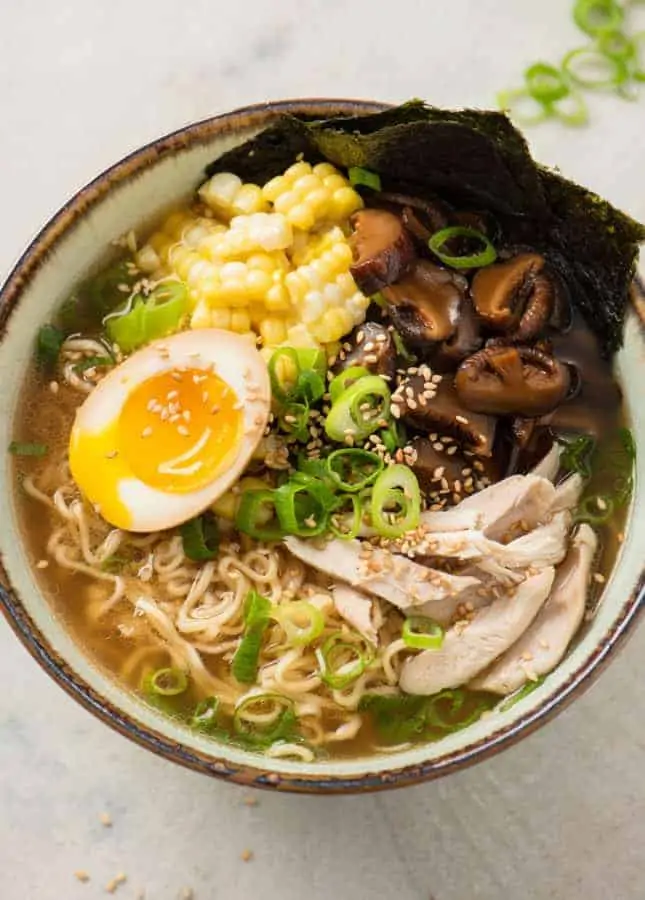
How to Assemble and Serve Momofuku Ramen
Ingredients
PER SERVING:
- 2 cups ramen broth
- 6 oz fresh ramen noodles, or 3 oz (85 g) dried noodles of your choice
- ½ cup cooked meat (shredded chicken from the broth, shredded pork, or pork belly)
- ¼ to ½ cup seasonal vegetables, blanched (corn, bean sprouts, broccoli, spinach, carrots, etc.)
- 1 ramen egg sliced in half (get the recipe to make these at the bottom of my main Momofuku Ramen post)
- ¼ cup thinly sliced green onions (green and white parts)
- 2 3-in (7.5 cm) square pieces of nori (cut out from larger sheets)
Additional optional toppings
- Slices of fish cakes (“naruto”)
- Bamboo shoots
- Toasted sesame seeds
- Furikake
Instructions
Prepare all the Momofuku ramen components:
- Bring the ramen broth to a simmer. Cook the noodles. Slice and blanch the vegetables. Slice the green onions. Get all the remaining components close to your workstation.
- Lay the noodles in the bottom of the serving bowl. Arrange the meat and the vegetables over the noodles. Ladle the broth over. Top with the halved ramen egg and the green onions. Tuck the nori about one-third of the way into one side of the soup, so they lean against the side of the bowl and stand up above the rim. Finish with the remaining toppings of your choice. Serve very hot.
- Recipe adapted from David Chang, Momofuku cookbook.
Did you make this?
Tell me how you liked it! Leave a comment or take a picture and tag it with @foodnouveau on Instagram.
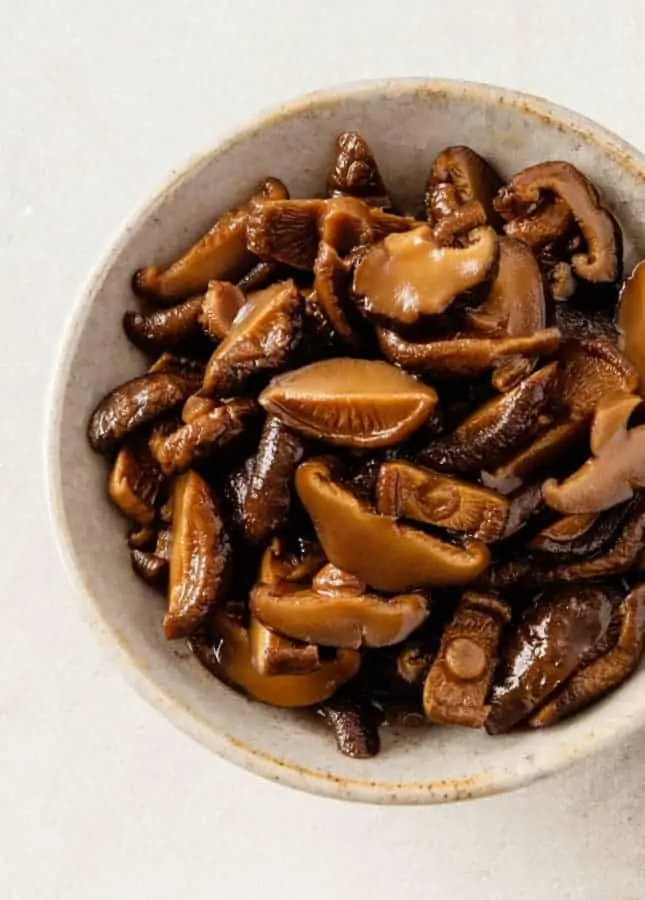
Pickled Shiitakes
Ingredients
- 2 cups rehydrated shiitakes from the ramen broth, or 1 cup/40 g dried shiitake caps steeped in boiling water for 30 minutes, then drained
- 1 cup ramen broth, or chicken broth
- ½ cup granulated sugar
- ½ cup Japanese soy sauce
- ½ cup sherry vinegar, or rice vinegar
- 1 3-in (7.5 cm) knob of fresh ginger, peeled and sliced
Instructions
- Cut the rehydrated shiitakes into 1/4-in-thick (0.6 cm) slices (discard the stems if there were any).
- In a saucepan, combine the broth, sugar, soy sauce, vinegar, and ginger. Stir in the sliced shiitakes and bring to a simmer. Lower the heat and keep to a slow simmer for 30 minutes. Let the shiitakes cool in the pickling liquid.
- Discard the ginger slices. Transfer the shiitakes to a jar and cover with the pickling liquid. The pickled shiitakes are ready to eat immediately. They will keep, refrigerated, for 1 month. Serve with ramen or enjoy as a snack.
- Recipe adapted from David Chang, Momofuku cookbook.
Did you make this?
Tell me how you liked it! Leave a comment or take a picture and tag it with @foodnouveau on Instagram.
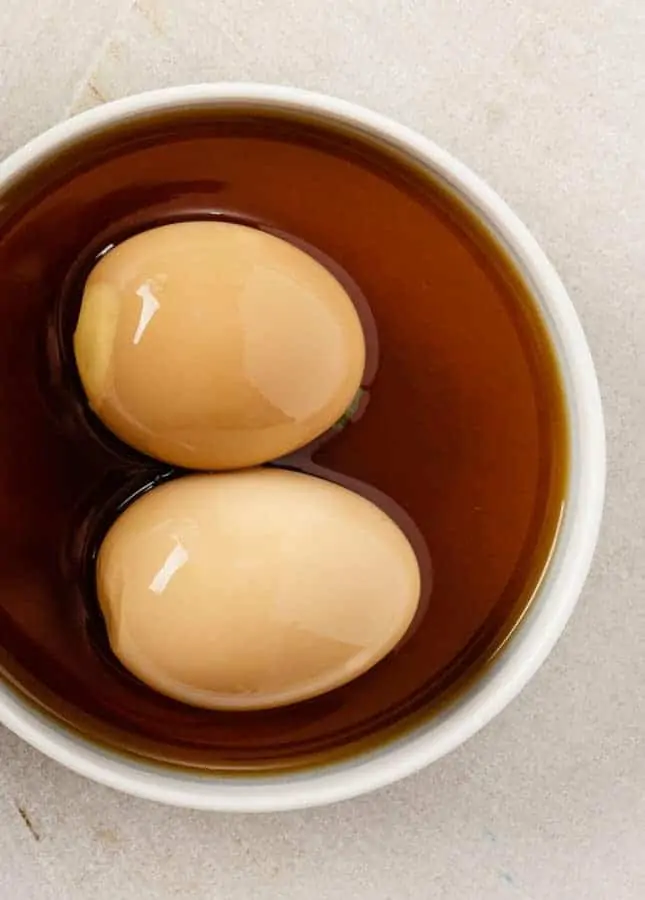
Easy Ramen Eggs
Ingredients
- 2 eggs
- ¼ cup water
- 2 tbsp Japanese soy sauce
- 2 tbsp mirin (rice cooking wine)
Instructions
- Place the eggs in a small saucepan. Fill the saucepan with water up to 1-in (2.5 cm) above the eggs. Set over high heat and bring to a boil. Lower the heat and simmer for exactly 7 minutes.
- While the eggs cook, fill a bowl with cold water and add ice to make it extra cold. When the eggs are done, immediately transfer them to the ice water bath and leave to cool for 10 minutes.
- In a small, resealable plastic bag, combine the water, soy sauce, and mirin. Carefully peel the eggs and transfer them to the marinade. Close the bag, making sure to remove all the air from the bag before you seal it. Refrigerate the eggs overnight, making sure the eggs remain completely submerged in the marinade (you can place the bag in a small container to force it to stand up.) Use within 4 days.
Did you make this?
Tell me how you liked it! Leave a comment or take a picture and tag it with @foodnouveau on Instagram.
This site is a participant in the Amazon Associates Program, an affiliate advertising program designed to provide a means for the site to earn fees by linking to Amazon and affiliated sites.
If you click on an affiliate link, I may earn advertising or referral fees if you make a purchase through such links, at no extra cost to you. This helps me creating new content for the blog–so thank you! Learn more about advertising on this site by reading my Disclosure Policy.
Author: Marie Asselin

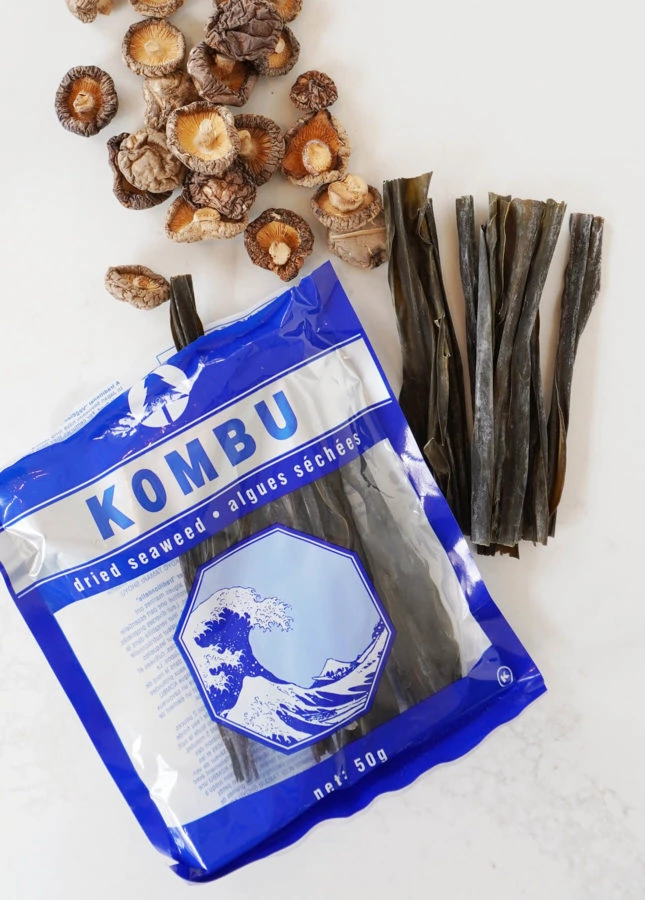
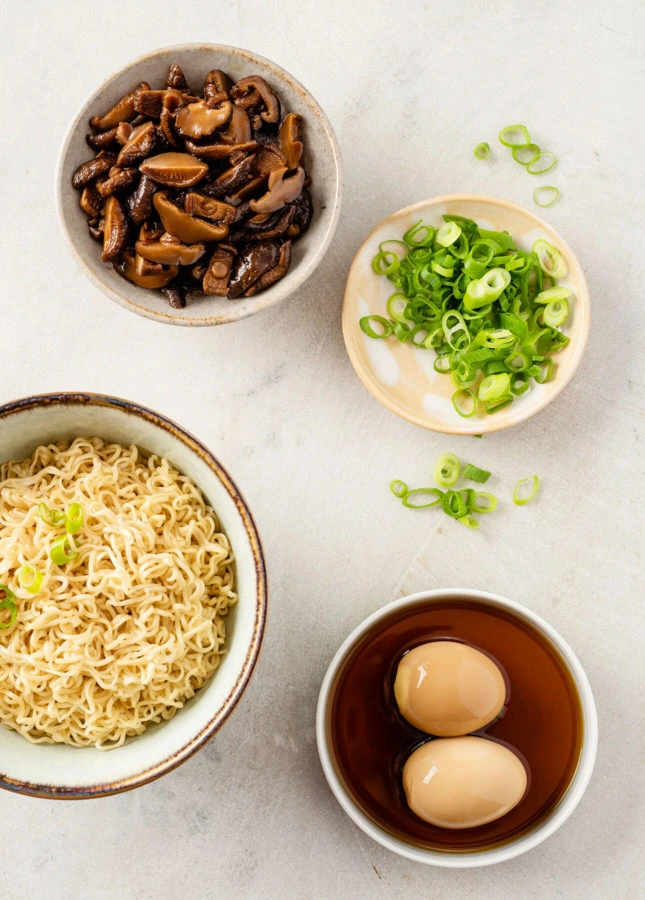
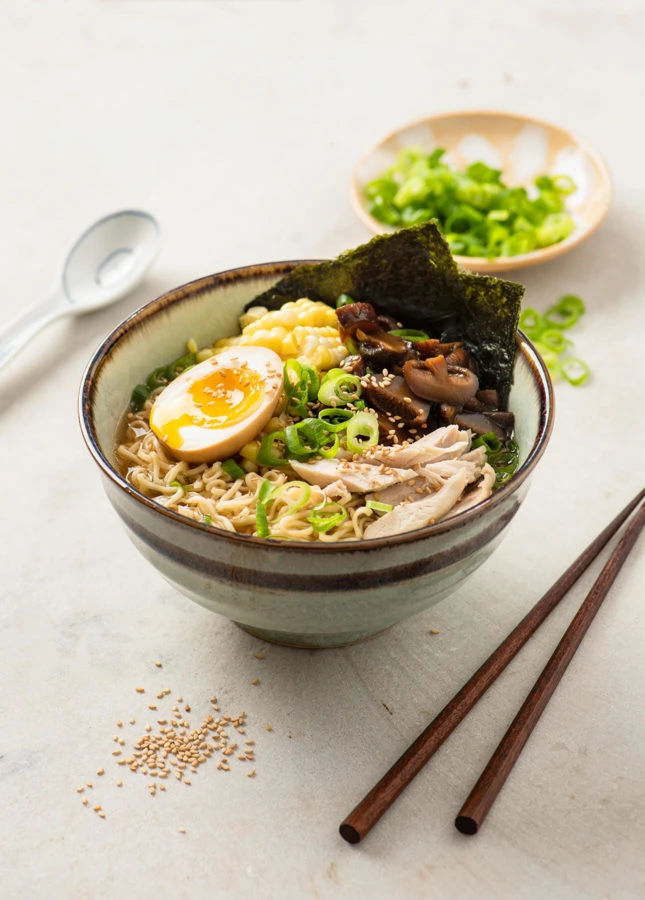
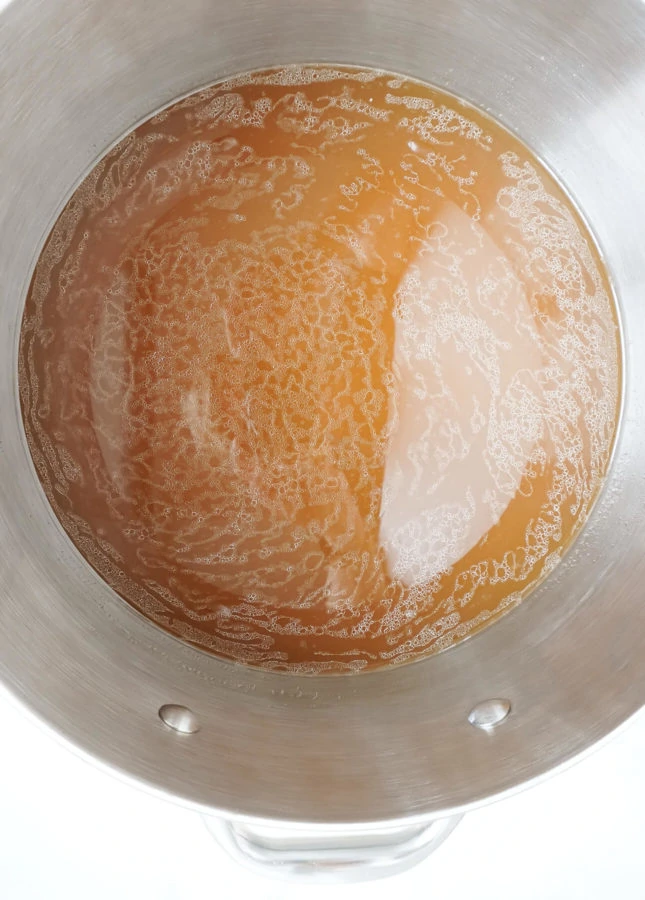
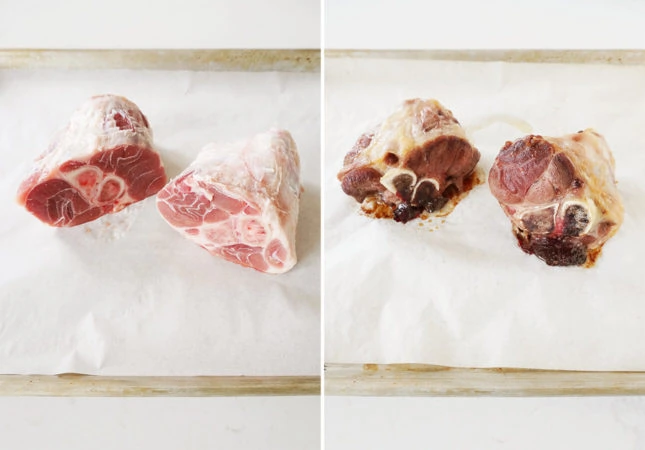

I love ramen, and a David Chang recipe, even better, thank you for the very detailed walk through, have never made a real ramen before, so for these steps, am very grateful!
This sure is a project but it’s so deliciously rewarding! Hits the spot, especially when you don’t live close enough to a Momofuku restaurant to satisfy your ramen cravings 😉
If you want this to be really great you’ve got to cook it WAY LONGER!!!!! Those bones should simmer for at least a day to get some real depth of flavor.
David’s cookbook is amazing, as are his restaurants in NYC. I frequent the Noodle and Ssam bars, but I have also had the privilege to go to Ko as well, which only seats 12 a night and you basically have to sit at your computer every day to try and get a reservation at exactly 10am. They are all gone within 30 seconds usually.
I do want to say that his ramen recipe, while delicious, is definitely not traditional tonkotsu pork ramen. David has said that he doesnt even want to try and replicate it bc the Japanese in Japan take it extremely seriously (See Tampopo the movie for a glimpse of their ramen fever!). Traditional tonkotsu (pork broth) ramen is far more rich than his and requires over 12 hours of cooking down pork bones (and chicken alot of times). It does not have shredded pork either most of the time, just chiasu (pork belly).
That being said, David is right, the toppings and combo’s are endless, but there still is a traditional way to prepare tonkotsu ramen which originates in Kyushu. Every area of Japan has its own version of ramen. When you do come to NYC most certainly get to David Chang’s restaurants, but also get to Ippudo for a taste of traditional tonkotsu.
Thank you so much for sharing this! Must have been divine. You have convinced me to get his cookbook as well. What a beautiful job you did!